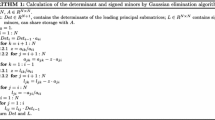Abstract
A new version of the Ruffini–Horner rule is presented for the evaluation of a polynomial of degree n at a point. In the PRAM model of parallel computation the new algorithm requires log n parallel steps with n/2+1 processors and the total number of arithmetic operations is n+⌈log2(n+1)⌉ -1 multiplications and n additions. If the polynomial is sparse, i.e., the number of nonzero coefficients is k≪ n, then the total number of operations is at most k(⌈log n⌉- ⌊log k⌋)+2k+⌈log n⌉. Moreover, similarly to the customary Ruffini–Horner rule, the algorithm is backward numerically stable. In other words, the value provided by applying the algorithm in floating point arithmetic with machine precision μ coincides with the value taken on at the same point by a slightly perturbed polynomial.
Similar content being viewed by others
References
O. Aberth, Iteration methods for finding all zeros of a polynomial simultaneously, Math. Comp. 27(122) (1973) 339–344.
D.A. Bini, Numerical computation of polynomial zeros by means of Aberth's method, Numer. Algorithms 13 (1996) 179–200.
D.A. Bini and V. Burchielli, Mpsolve 1.0: A Fortran 90 Package for the numerical computation of polynomial roots, Technical Report, Dipartimento di Matematica, Università di Pisa (1997).
D.A. Bini and G. Fiorentino, Adaptive multiprecision algorithm for univariate polynomial zeros, in: Proc. of the 1st Internat. MATHEMATICA Symposium (Computational Mechanics Publications, Southampton, 1995) pp. 53–60.
D.A. Bini and G. Fiorentino, A multiprecision implementation of a poly-algorithm for univariate polynomial zeros, in: Proc. of the POSSO Workshop on Software, eds. J.C. Faugère, J. Marchand and R. Rioboo (1995).
D.A. Bini and G. Fiorentino, Mpsolve: Numerical computation of polynomial roots v2.0, Technical FRISCO Report (1998).
W. Börsch-Supan, A-posteriori error bounds for the zeros of polynomials, Numer. Math. 5 (1963) 380–398.
E. Durand, Solutions Numériques des Équations Algébriques, Tome 1: Equations du Type F(X) = 0; Racines d'un Polynôme (Masson, Paris, 1960).
L.W. Ehrlich, A modified Newton method for polynomials, Comm. ACM 10(2) (1967) 107–108.
E. Hansen, M. Patrick and J. Rusnak, Some modifications of Laguerre's method, BIT 17 (1977) 409–417.
M.A. Jenkins and J.F. Traub, A three stage variable shift iteration for polynomial zeros and its relation to generalized Rayleigh iteration, Numer. Math. 14 (1970) 252–263.
I.O. Kerner, Ein Gesamtschrittverfahren zur Berechnung der Nullstellen von Polynomen, Numer. Math. 8 (1966) 290–294.
K. Madsen and J. Reid, Fortran subroutines for finding polynomial zeros, Technical Report HL 75/1172(C.13), Computer Science and Systems Divisions, A.E.R.E. Harwell, Oxford (1975).
V.H. Maehly, Zur iterativen Auflösing algebraischer Gleichungen, Z. Angew. Math. Phys. 5 (1954) 260–263.
S. Tričković M.S. Petković and S. Ilić, A family of simultaneous zero finding methods, Comput. Math. Appl. 34 (1997) 49–59.
A.W.M. Nourein, An improvement on Nourein's method for the simultaneous determination of the zeros of a polynomial (an algorithm), J. Comput. Appl. Math. 3 (1977) 109–110.
A.W.M. Nourein, An improvement on two iteration methods for simultaneous determination of the zeros of a polynomial, Internat. J. Comput. Math. 6 (1977) 241–252.
V.Y. Pan, On methods of computing the values of polynomials, Uspekhi Mat. Nauk 21(1) (127) (1966) 103–134.
K. Weierstrass, Neuer Beweis des Satzes, dass jede ganze rationale Funktion einer Veränderlichen dargestellt werden kann als ein Product aus linearen Functionen derselben Veränderlichen, in: Gesammelte Werke, Vol. 3 (1903), pp. 251–269. (Johnson Reprint Corp., New York, 1967.)
W. Werner, On the simultaneous determination of polynomial roots, Lecture Notes in Mathematics 953 (Springer, New York, 1982) pp. 188–202.
Author information
Authors and Affiliations
Rights and permissions
About this article
Cite this article
Bini, D.A., Fiorentino, G. On the parallel evaluation of a sparse polynomial at a point. Numerical Algorithms 20, 323–329 (1999). https://doi.org/10.1023/A:1019116203957
Issue Date:
DOI: https://doi.org/10.1023/A:1019116203957




